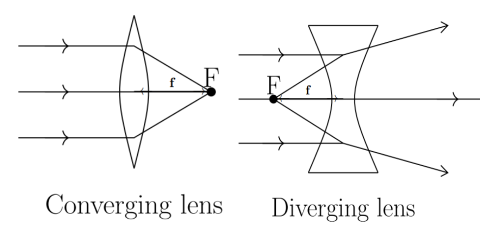
Converging and diverging of light rays is the property for which of the given pairs
A. Concave lens and Plane mirror respectively
B. Convex lens and Plane mirror respectively
C. Concave lens and convex lens respectively
D. Convex lens and concave lens respectively
Answer
423.9k+ views
Hint: A concave lens is a lens that possesses at least one surface that curves inwards. It spreads out light rays that have been refracted through it. Whereas a convex lens is a lens that converges the incident rays towards the principal axis after refraction through a point called focus, since it converges all the ray at one point.
Complete answer:
If both sides of the lens curve outward, it is called a converging lens, and it will bend light from distant objects inwards toward a single point, called the focal point(F). A ray entering a converging lens through its focal point exits parallel to its axis. If both sides of the lens curve inward, it is called a diverging lens, and light from distant objects will bend outwards. A ray that enters a diverging lens by heading toward the focal point on the opposite side exits parallel to the axis.

Thus, a convex lens is a converging lens because it converges a parallel beam of light rays passing through it at its focus and concave lens is a diverging lens because it diverges the parallel beam of rays passing through it.
Hence the correct option is D.
Note: A ray passing through the centre of either a converging or a diverging lens does not change direction. Light travels more slowly inside a lens than the air and the lenses can actually steer light to the direction we want. The curvature of a lens can make different rays of a light beam refract through different angles. Also note that the diverging rays can be traced backwards until they intersect at a point.
Complete answer:
If both sides of the lens curve outward, it is called a converging lens, and it will bend light from distant objects inwards toward a single point, called the focal point(F). A ray entering a converging lens through its focal point exits parallel to its axis. If both sides of the lens curve inward, it is called a diverging lens, and light from distant objects will bend outwards. A ray that enters a diverging lens by heading toward the focal point on the opposite side exits parallel to the axis.

Thus, a convex lens is a converging lens because it converges a parallel beam of light rays passing through it at its focus and concave lens is a diverging lens because it diverges the parallel beam of rays passing through it.
Hence the correct option is D.
Note: A ray passing through the centre of either a converging or a diverging lens does not change direction. Light travels more slowly inside a lens than the air and the lenses can actually steer light to the direction we want. The curvature of a lens can make different rays of a light beam refract through different angles. Also note that the diverging rays can be traced backwards until they intersect at a point.
Recently Updated Pages
Master Class 11 Chemistry: Engaging Questions & Answers for Success

Master Class 11 Biology: Engaging Questions & Answers for Success

Class 11 Question and Answer - Your Ultimate Solutions Guide

Master Class 11 Business Studies: Engaging Questions & Answers for Success

Master Class 11 Accountancy: Engaging Questions & Answers for Success

Master Class 11 Computer Science: Engaging Questions & Answers for Success

Trending doubts
A boat goes 24 km upstream and 28 km downstream in class 10 maths CBSE

Why is there a time difference of about 5 hours between class 10 social science CBSE

The Equation xxx + 2 is Satisfied when x is Equal to Class 10 Maths

What is the full form of POSCO class 10 social science CBSE

Change the following sentences into negative and interrogative class 10 english CBSE

How do you prove that the diagonals of a rectangle class 10 maths CBSE




